Talgo Bundle
How Does Talgo Navigate the High-Speed Rail Race?
In the fast-paced world of railway technology, Talgo has carved a niche with its innovative approach to train design. But who are its main rivals, and how does it maintain its competitive edge? This analysis dives deep into the Talgo SWOT Analysis, uncovering the strategies and challenges shaping its future in the global market.
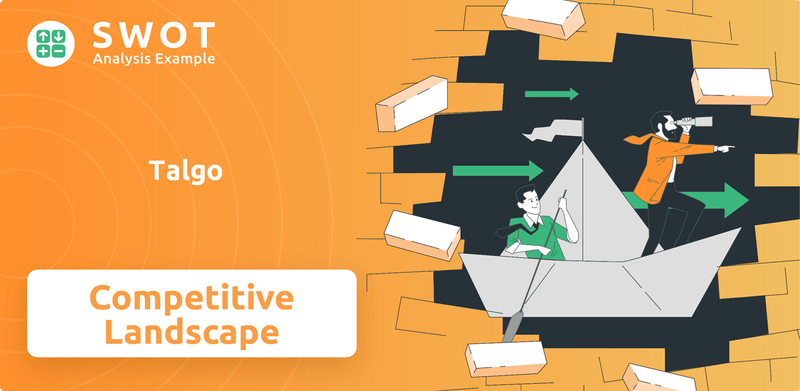
Understanding the Talgo competitive landscape is crucial for anyone invested in the high-speed rail industry. This report offers a comprehensive Talgo market analysis, evaluating its position against key Talgo competitors like Siemens and Alstom. We'll explore Talgo's competitive advantages and disadvantages, examining its global presence and market positioning to provide actionable insights for investors and industry professionals alike.
Where Does Talgo’ Stand in the Current Market?
Talgo's core operations revolve around the design, manufacturing, and maintenance of railway rolling stock, with a primary focus on high-speed and intercity trains. They offer comprehensive services, including refurbishment and maintenance, to support the lifecycle of their trains. This specialization allows them to cater to national railway operators and private entities seeking advanced and efficient rail transport solutions.
The value proposition of Talgo lies in its innovative approach to train design, particularly its lightweight construction and independent wheel technology. This technology provides enhanced performance on existing infrastructure without requiring extensive modifications. This is especially beneficial in markets where infrastructure upgrades are costly or time-consuming. The company's emphasis on technological advancements positions it as a key player in the Growth Strategy of Talgo.
While precise market share figures for 2024-2025 are not readily available, Talgo maintains a strong presence in the Spanish domestic market and has expanded significantly internationally. Key markets include Germany, Denmark, Saudi Arabia, and the United States. Their focus on high-speed and intercity trains allows them to compete effectively in specific segments of the train manufacturing industry.
Talgo's primary product lines include the Talgo Avril, a very high-speed train capable of reaching 380 km/h, and various regional and intercity train sets. They also offer comprehensive maintenance and refurbishment services. This diversified approach allows Talgo to meet the varied needs of railway operators and maintain a competitive edge in the high-speed rail industry.
In 2023, Talgo reported revenues of €652 million. This reflects the company's robust operational scale and strong order book. While smaller than some multinational competitors, Talgo's specialized focus and technological advantages enable it to maintain a strong competitive stance.
Talgo's competitive advantages include its unique lightweight construction and independent wheel technology, which allows for better performance on existing infrastructure. This is particularly beneficial in markets where infrastructure upgrades are challenging. Their focus on innovation in train design and sustainability initiatives in rail also contributes to their competitive edge.
Talgo's market position is defined by its specialization in high-speed and intercity trains, and its technological innovations. The company competes in the global railway rolling stock market, focusing on specific segments. Their financial performance, with €652 million in revenue in 2023, demonstrates their operational scale and strong market presence.
- Specialization in high-speed and intercity trains.
- Technological advantages, including lightweight construction and independent wheel technology.
- Strong presence in key international markets like Germany and the United States.
- Focus on providing comprehensive maintenance and refurbishment services.
Talgo SWOT Analysis
- Complete SWOT Breakdown
- Fully Customizable
- Editable in Excel & Word
- Professional Formatting
- Investor-Ready Format
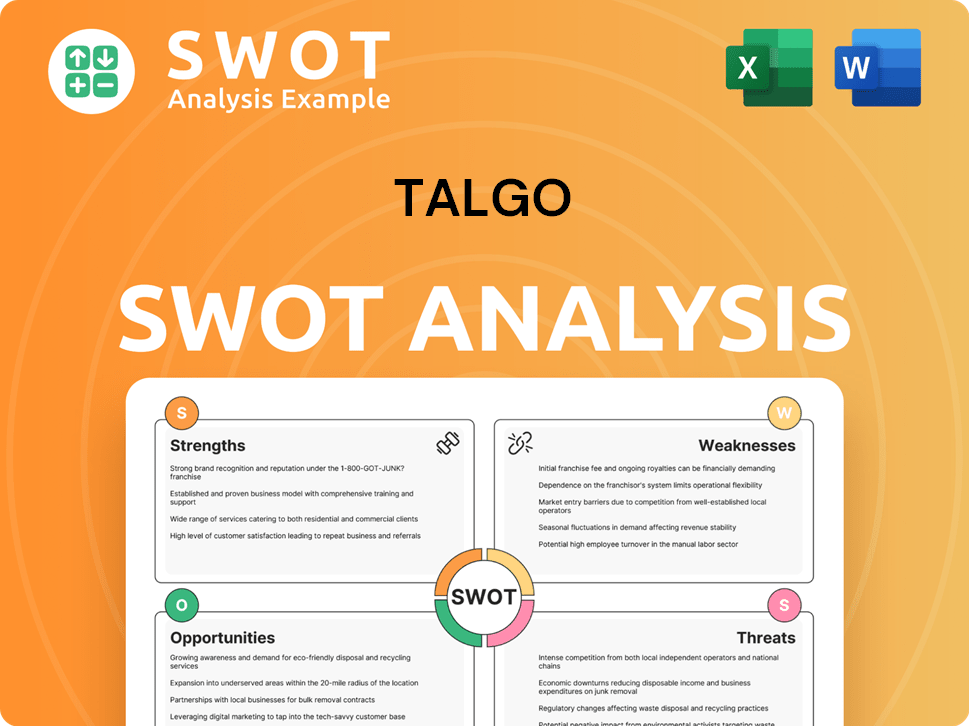
Who Are the Main Competitors Challenging Talgo?
The Talgo competitive landscape is shaped by a dynamic global railway industry, where several major players vie for market share. Talgo market analysis reveals a competitive environment characterized by both direct and indirect competitors, each with unique strengths and strategies. Understanding these competitors is crucial for assessing Talgo's competitors position and future prospects.
The railway industry is experiencing growth, with increasing investments in high-speed rail and urban transit systems. This growth fuels competition among train manufacturers and railway technology providers. The competitive dynamics are influenced by technological advancements, government regulations, and regional economic conditions.
The primary competitors of Talgo include established multinational corporations and emerging players. These companies compete on various fronts, including product offerings, geographical reach, and pricing strategies. The competitive landscape is further complicated by the evolving needs of railway operators and the growing emphasis on sustainability and innovation.
Alstom is a major player in the high-speed rail industry, offering a wide range of railway products and services. The company's extensive global network and diverse portfolio give it a significant competitive advantage. Alstom's financial performance in recent years has been strong, with increasing revenues and a solid order backlog.
Siemens Mobility is another key competitor, known for its advanced train technology and signaling solutions. Siemens has a strong presence in Europe and is expanding its global footprint. The company's emphasis on innovation and sustainability positions it well in the evolving railway market.
CRRC is the world's largest train manufacturing company, with a dominant position in the Chinese market. CRRC's competitive advantage lies in its scale and cost-effectiveness. The company's expansion into international markets poses a significant challenge to established players.
Hitachi Rail has a growing presence in the railway sector, particularly in high-speed rail and metro systems. The company's technological expertise and strategic acquisitions have strengthened its position. Hitachi Rail's focus on innovation and customer service is a key differentiator.
These competitors employ different strategies to gain market share. Alstom and Siemens leverage their broad product portfolios and global networks. CRRC focuses on cost leadership and large-scale production. Hitachi Rail emphasizes technological innovation and strategic partnerships.
Talgo differentiates itself with its unique train architecture and operational efficiency. The company often secures contracts due to its specialized technology. Talgo's focus on innovation and customer-specific solutions helps it compete against larger rivals.
The railway industry is subject to continuous change, driven by technological advancements and evolving customer demands. Talgo's global presence and market positioning are influenced by these trends. Emerging technologies, such as hyperloop concepts, also pose indirect competition.
- High-Speed Rail Projects: Talgo frequently bids against Alstom, Siemens, and CRRC for high-speed rail projects in Europe and the Middle East.
- Technological Innovation: The development of new train designs and railway technology is a key area of competition.
- Sustainability: Talgo's sustainability initiatives in rail and those of its competitors are increasingly important.
- Market Expansion: Talgo's strategies for market expansion include targeting new regions and customer segments.
Talgo PESTLE Analysis
- Covers All 6 PESTLE Categories
- No Research Needed – Save Hours of Work
- Built by Experts, Trusted by Consultants
- Instant Download, Ready to Use
- 100% Editable, Fully Customizable
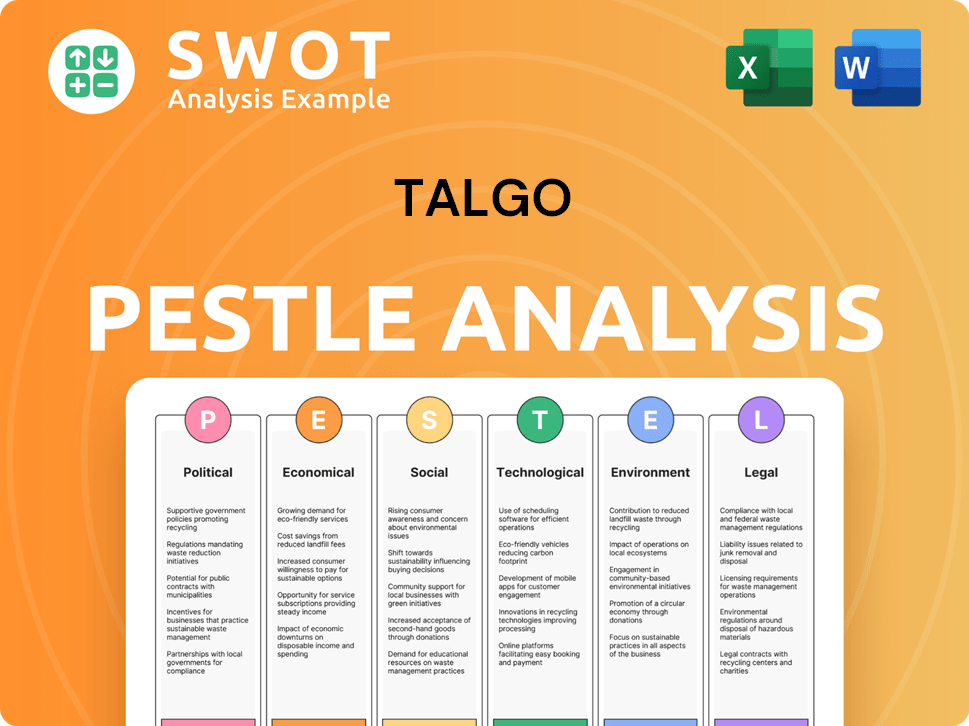
What Gives Talgo a Competitive Edge Over Its Rivals?
Examining the Target Market of Talgo reveals several key competitive advantages that position it uniquely within the high-speed rail industry. These advantages stem from its innovative train designs and operational strategies, enabling it to offer superior value to railway operators globally. Understanding these strengths is crucial for a comprehensive Talgo market analysis.
Talgo's competitive edge is built on a foundation of technological innovation and operational efficiency. The company's focus on lightweight designs and the 'Talgo Pendular' tilting system allows for higher speeds on curves, reducing energy consumption and infrastructure wear. This approach, combined with its independent wheel system, contributes to smoother rides and lower maintenance costs, setting it apart in the train manufacturing sector.
Furthermore, Talgo's commitment to providing comprehensive maintenance and refurbishment services fosters strong customer loyalty and recurring revenue. Its ability to tailor solutions to meet specific client requirements, paired with a solid brand reputation for reliability, strengthens its market position. This focus on customer service and technological advancement is central to its strategy within the competitive landscape.
Talgo's proprietary technologies, such as the 'Talgo Pendular' tilting system and lightweight train designs, offer significant advantages. These innovations allow trains to operate at higher speeds on existing infrastructure, reducing the need for costly upgrades. These advancements are protected by patents, creating barriers to entry for competitors.
The company's focus on energy efficiency and reduced infrastructure wear provides operational cost savings for railway operators. The independent wheel system contributes to lower maintenance expenses and a smoother passenger experience. These efficiencies are key in the high-speed rail industry.
Talgo's comprehensive maintenance and refurbishment services foster strong customer relationships and generate recurring revenue streams. The ability to provide bespoke solutions tailored to client needs reinforces its market position. This approach ensures customer satisfaction and loyalty.
Talgo's strong brand reputation for reliability and innovation enhances its market standing. The company's commitment to quality and technological advancement has solidified its position in the global railway market. This reputation helps in securing long-term contracts and expanding its global footprint.
Talgo's competitive advantages are significant, but the company faces challenges from competitors investing in high-speed technologies. Talgo continues to leverage its strengths in marketing, product development, and strategic partnerships to secure long-term contracts and expand globally.
- Technological Innovation: Lightweight designs and the 'Talgo Pendular' system.
- Operational Efficiency: Reduced energy consumption and lower infrastructure wear.
- Customer Service: Comprehensive maintenance and refurbishment services.
- Brand Reputation: Reliability and innovation in the railway industry.
Talgo Business Model Canvas
- Complete 9-Block Business Model Canvas
- Effortlessly Communicate Your Business Strategy
- Investor-Ready BMC Format
- 100% Editable and Customizable
- Clear and Structured Layout
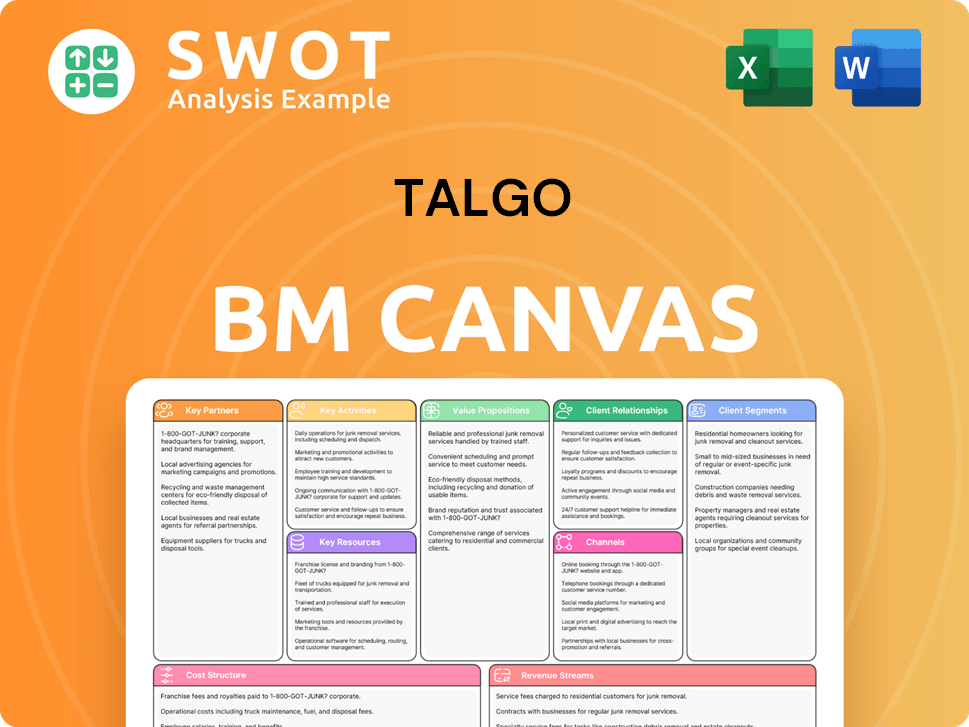
What Industry Trends Are Reshaping Talgo’s Competitive Landscape?
The railway industry is currently experiencing significant shifts, driven by a global emphasis on sustainable transportation and technological advancements. This dynamic environment presents both challenges and opportunities for companies like Talgo. Understanding the Revenue Streams & Business Model of Talgo is crucial for assessing its competitive position and future prospects.
The competitive landscape for train manufacturers is intense, with companies vying for market share in a rapidly evolving industry. Factors such as innovation in train design, sustainability initiatives, and strategic partnerships are key in determining success. This analysis will explore the industry trends, future challenges, and opportunities that shape Talgo's competitive position.
The high-speed rail industry is seeing growth, especially in emerging markets. There's a strong push towards sustainable transportation, with increased demand for energy-efficient solutions. Digitalization, including predictive maintenance and advanced signaling, is transforming railway operations.
Talgo faces the challenge of keeping pace with rapid technological advancements. Increased regulatory scrutiny regarding safety and environmental standards requires continuous adaptation. Potential disruption from new technologies like hyperloop could also impact the traditional rail model.
Growing global demand for high-speed rail presents significant opportunities for Talgo. The company's specialized technology is well-suited for markets with infrastructure limitations. Further innovation in areas like autonomous trains and enhanced passenger experience can open new revenue streams.
Strategic partnerships with local manufacturers can facilitate market expansion. Deepening specialization in high-performance, sustainable rail solutions is crucial. Leveraging unique engineering capabilities will help Talgo remain resilient in a dynamic global market.
The
- Technological Innovation: Talgo's ability to innovate in train design and incorporate sustainability initiatives is critical.
- Market Expansion: Strategic partnerships and a focus on emerging markets are essential for growth.
- Competitive Positioning: Comparing Talgo vs. Siemens rail and Talgo vs. Alstom highlights the need for differentiation.
- Financial Performance: Analyzing Talgo's financial performance compared to competitors is crucial for assessing its long-term viability.
Talgo Porter's Five Forces Analysis
- Covers All 5 Competitive Forces in Detail
- Structured for Consultants, Students, and Founders
- 100% Editable in Microsoft Word & Excel
- Instant Digital Download – Use Immediately
- Compatible with Mac & PC – Fully Unlocked
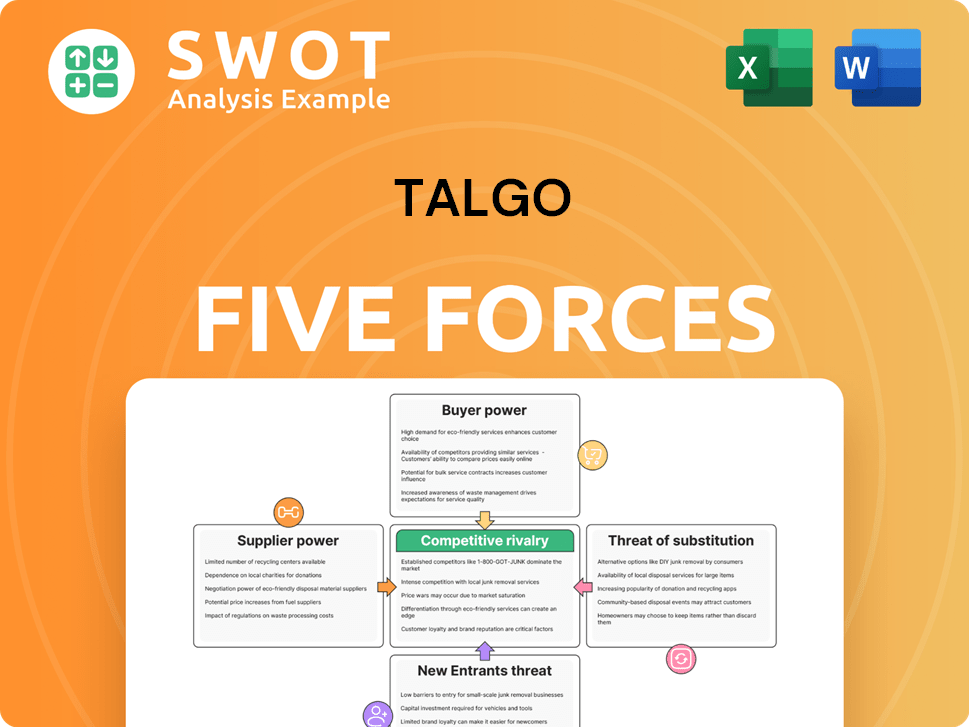
Related Blogs
- What are Mission Vision & Core Values of Talgo Company?
- What is Growth Strategy and Future Prospects of Talgo Company?
- How Does Talgo Company Work?
- What is Sales and Marketing Strategy of Talgo Company?
- What is Brief History of Talgo Company?
- Who Owns Talgo Company?
- What is Customer Demographics and Target Market of Talgo Company?
Disclaimer
All information, articles, and product details provided on this website are for general informational and educational purposes only. We do not claim any ownership over, nor do we intend to infringe upon, any trademarks, copyrights, logos, brand names, or other intellectual property mentioned or depicted on this site. Such intellectual property remains the property of its respective owners, and any references here are made solely for identification or informational purposes, without implying any affiliation, endorsement, or partnership.
We make no representations or warranties, express or implied, regarding the accuracy, completeness, or suitability of any content or products presented. Nothing on this website should be construed as legal, tax, investment, financial, medical, or other professional advice. In addition, no part of this site—including articles or product references—constitutes a solicitation, recommendation, endorsement, advertisement, or offer to buy or sell any securities, franchises, or other financial instruments, particularly in jurisdictions where such activity would be unlawful.
All content is of a general nature and may not address the specific circumstances of any individual or entity. It is not a substitute for professional advice or services. Any actions you take based on the information provided here are strictly at your own risk. You accept full responsibility for any decisions or outcomes arising from your use of this website and agree to release us from any liability in connection with your use of, or reliance upon, the content or products found herein.